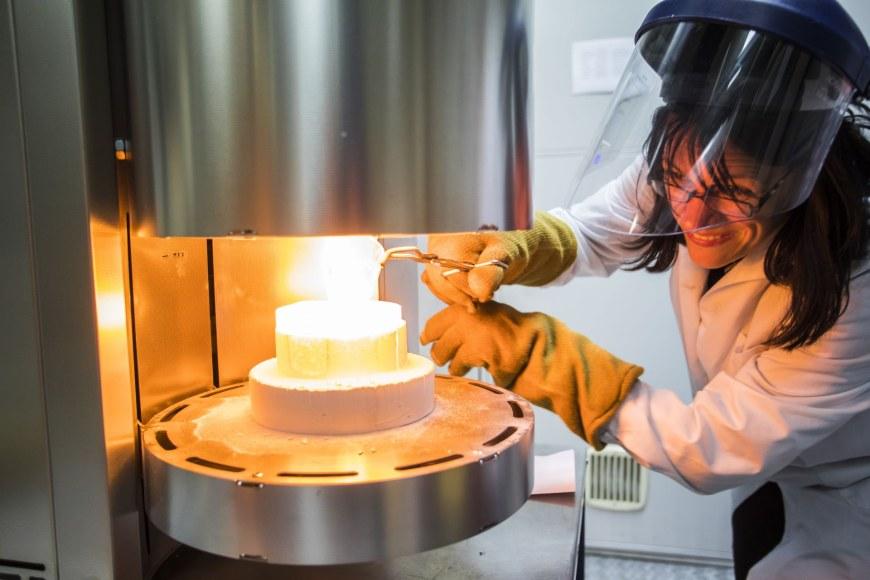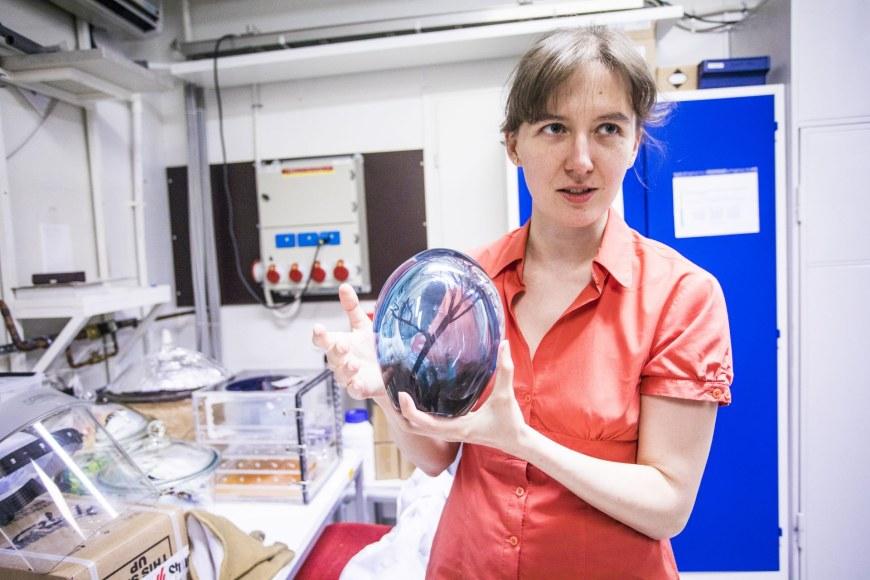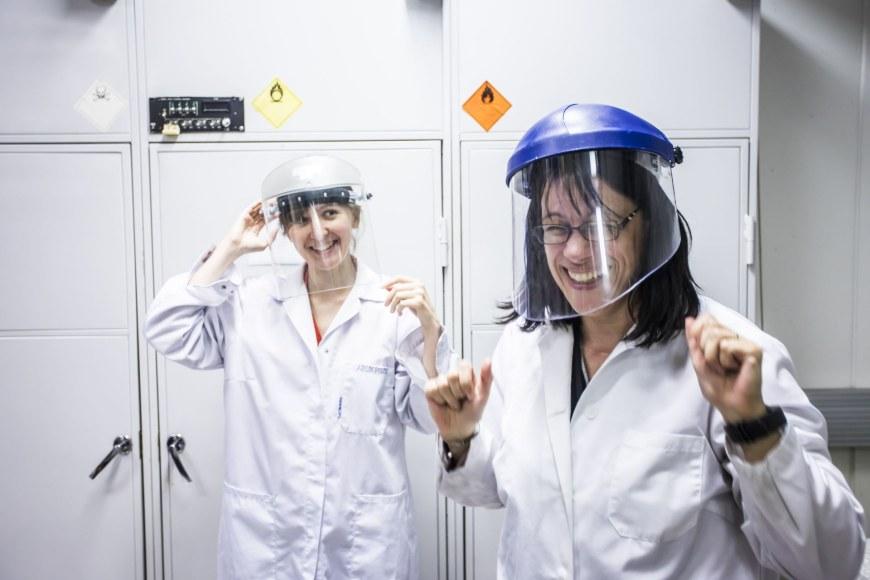In search of the perfect yellow. Glass scientist and glass artist join forces to develop new glass colours

For Laeticia Petit, making glass is like cooking: you add a little bit of this and a little bit of that, and then you evaluate the outcome. And just like cooking, glass making at its best combines science and art.
Tenure Track Professor Petit works with photonics at Tampere University and, in a side project, develops custom-made colours for Glass Artist Ella Varvio. Varvio is known as an artist-designer who combines artisanal mouth-blown glass with illustrated storytelling.
The cooperation sparked off at Petit’s workshop that was funded by the Ceramic and Glass Industry Foundation. The idea behind the workshop was to spread information on glass and ceramic research and the potential it holds.
”Glass science is a withering field of study. People assume that we already know everything there is to know about glass, since we have used and studied it for so long. The truth is quite the opposite: many current and future applications are based on glass, and the potential of new innovations is mind-blowing,” Petit says.

Ideas flow both ways
Ella Varvio heard about Petit’s workshop from a friend. Once they met, the scientist and the artist found common areas of interest and their cooperation started off.
”Artists are always curious about their materials. Working with scientists gives a lot of new perspective. I actually have a painter-like attitude towards glass art: colours associate with moods and atmospheres. That’s why it is so great to have and use your very own, unique colours,” Varvio explains.
Currently, Varvio is making unique glass artwork pieces, but she has also made plans for small-scale serial production. Going forward, we may see urban themes in her work.
”I spent some time in New York and made a lot of drawings there. New colours could complement those moods quite nicely,” she notes.
For Petit, colour experiments with art glass are more of a fun side project than actual research, but collaboration with an artist feels fulfilling. New thoughts may arise from either party. This is what happens when Varvio shows a piece in which a dark tree silhouette seems to be floating inside blue glass.
”This glass was blown twice. First one layer, on top of which I printed a silk-screen tree silhouette, and then another layer. The tree is reflected on the layers and seems to be hovering or swaying,” Varvio says.
”The two-layered design and glass reflections are interesting ideas. Solar cells, for example, also contain multiple layers,” Petit notes.

Glass has many sides to it
Few scientists work with glass. When Laeticia Petit moved to Finland a few years ago, none of her colleagues had acquainted themselves with the glass used in photonics research. Tampere is home to a fantastic glass research infrastructure, however.
”Our campus in Hervanta has everything we need to make and analyse glass. Our new Microscopy Center has proven very popular.”
The glasses that Petit studies have wide-ranging application potential from biomedicine to various sensors and metal-cutting fibre lasers.
”Bioactive glass can be used for treating bone fractures, for example, as it slowly turns into bone in the human body. Laser fibres can be used for cutting metal or in sensors, for example. Fibres are also studied for the purpose of bladder cancer identification,” Petit notes.
One of Petit’s research subjects is glass that contains nano-sized ceramic crystals.
”It looks like ordinary glass, but the crystals make it highly versatile. The manufacture process is challenging, as the temperature, for example, has to be just perfect. Otherwise the crystals do not work or they melt into the glass. Crystal glass has very promising application potential in areas such as biomedicine.”
Young people who are seeking their future career paths are not very familiar with new innovations of this kind. One purpose of the workshop, arranged in summer 2018, was to spread word on glass and ceramic research and explain why these areas are still well worth studying.
”For young scientists, glass is not as cool as polymers, for example,” Petit notes.

This batch is for frogs
The reputation of glass research could be turned through joint projects such as the one engaged in by Petit and Varvio. Take cooking, for example. It became a trendy hobby for young hipsters just some years ago. Collaboration between art and science can give a similar facelift to glass than the one given to traditional home cooking by celebrity chefs.
”The colours are delicious! They are incredibly rich, as they are so full and thorough. In the old days, glass factories had their own chemists who prepared colours. Today, artists usually have colourless glass in their studios and they mix them with colour powder they have ordered from suppliers. The results are not always that good,” Ella Varvio says.
The test batches that Petit prepares in her laboratory are made in small, 25-gram bowls in an oven heated to 1,600 degrees Celsius. Magnesium, titanium or iron in various proportions, for example, is mixed into the mass, resulting in different colours. Experimenting is cheap with these tiny laboratory batches – artists make production lots weighing dozens of kilos in their studios.
”In addition to the mixture ratio, factors such as temperature and melting time affect the colour. Glass manufacture takes precision. Some of the colour agents are toxic and therefore nowadays forbidden. Bright red colour, for example, is difficult and expensive to make,” Petit explains.
At the moment, Petit is developing a bright yellow colour for Varvio, along with glass that changes colour from blue to purple. The scientist’s table is full of different experiment outcomes: various shades of blue and a range of yellows from very light to gingery.
”The mixture ratio in the brown one was too strong, so the colour turned out pretty ugly. Then again, maybe you could try and make some fancy glass frogs out of it,” Petit says and smirks.
“Once, we managed to make glass with colour alternating from brown to blue with the light. We were too slow to analyse what exactly happened there, but it was very interesting,” Petit says.
And this is exactly what Petit wants to pass on to her students: there are no good or bad results in science, only interesting ones.
”You never know what you accidentally create and what kind of surprising applications you may find for it somewhere down the road.”
Author: Sanna Kähkönen






